Have you watched shoppers add products to their carts only to disappear without completing their purchase?s As eCommerce store owners ourselves, we sure have. So we know it can be devastating.
The numbers are eye-opening: according to recent studies, the average shopping cart abandonment rate sits at around 70%. That means for every 10 potential customers who add items to their cart, 7 of them leave without buying.
But here’s the good news – with the right strategies, you can recover many of these lost sales.
That’s why we’ve put together this comprehensive guide on shopping cart abandonment statistics. We’ve analyzed data from hundreds of eCommerce stores, consulted with industry experts, and compiled the most current research to help you understand why customers abandon their carts and what you can do about it.
Whether you’re running a small online store or managing a large eCommerce operation, these insights will help you boost your conversion rates and recover more sales.

💡Key Shopping Cart Abandonment Statistics: The Short Answer
- Overall Abandonment Rate: Nearly 70% of online shoppers leave items in their cart without making a purchase.
- Top Reason for Abandonment: Unexpected extra costs, such as high shipping fees and taxes, are a primary reason shoppers leave.
- Mobile vs. Desktop: The abandonment rate on mobile devices (around 80%) is significantly higher than on desktop computers (around 66%).
Ultimate List of Key Cart Abandonment Rate Statistics
To help you navigate this information easily, we have divided our online shopping cart abandonment statistics into different categories.
Just click the links below to jump to the section that interests you the most to view the different statistics:
- General Cart Abandonment Rates Across Industries
- Reasons Why Consumers Abandon Their Shopping Carts
- Checkout Optimization Trends to Prevent Cart Abandonment
- eCommerce Marketing Strategies to Solve Cart Abandonment
- Best Practices for Cart Abandonment Emails
- Store Policies That Can Make or Break Your Conversions
- eCommerce Tech Trends to Reduce Shopping Cart Abandonment
- Frequently Asked Questions About Shopping Cart Abandonment
- Discover More Stats and Trends to Optimize Your Online Store
General Cart Abandonment Rates Across Industries
Let’s start by looking at some eye-opening statistics about cart abandonment in general.
1. On average, about 7 out of 10 people abandon their online shopping carts before completing a purchase.
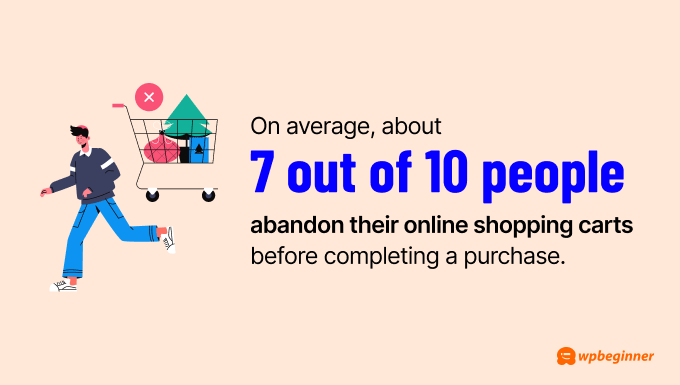
This means that for every 10 potential customers who add items to their shopping cart, only 3 are likely to complete their purchase.
As an online store owner, you have your work cut out to improve these numbers. Remember that even small improvements can lead to big gains, which we’ll discuss throughout this guide.
2. 60% of businesses don’t know their site’s cart abandonment rate.
Many eCommerce platforms don’t include a built-in cart abandonment tracker. While there is a formula you can use to calculate cart abandonment, it’s time-consuming, and the numbers change constantly as your online store operates 24/7.
That’s why we recommend using Google Analytics to track your cart abandonment stats. It’s a powerful, free tool that can provide valuable insights into your store’s performance.
If you’re using WordPress, connecting your online store to Google Analytics is even easier with MonsterInsights. This plugin can help you track conversions on WooCommerce and even show you the number of abandoned checkouts.

For more information, check out our MonsterInsights review.
3. Among all sectors, Luxury & Jewelry has the highest rate of shoppers leaving items in their online carts at 80%, while Pet Care & Veterinary Services has the lowest at 56%.
The high abandonment rate in the Luxury & Jewelry sector isn’t surprising. Shoppers often hesitate to invest a large sum of money without seeing the product in person.
On the other hand, pet owners seem more decisive when it comes to their furry friends. The lower abandonment rate in Pet Care could be because people are shopping for a loved one, leading to less doubt and quicker decisions.
Just as luxury shoppers need more reassurance and pet owners are driven by emotion, each industry has its unique customer needs.
For example, if you sell real estate, you may face challenges similar to those in the luxury sector. Simply uploading product pictures won’t be enough. You’ll need to provide detailed information and perhaps 360-degree views to help customers visualize the home.

4. Of all website traffic sources, search has the lowest cart abandonment rate at 76%, while social media has the highest at 91%.
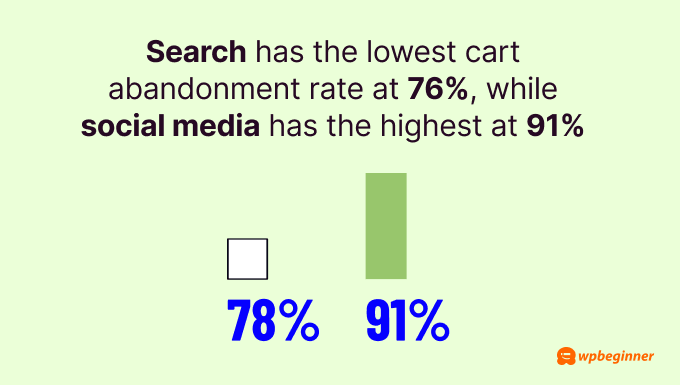
Search traffic usually comes with a specific intention to find and purchase something. When shoppers use search engines, they often know what they want, leading to more decisive purchasing behavior and a lower likelihood of abandoning their carts.
On the other hand, social media exposes users to ads, brands, and content that algorithms think they might like. This can lead to more impulse-driven browsing and add-to-cart actions, but less commitment to follow through with the purchase.
However, this doesn’t mean you should favor one traffic source over another. Instead, adjust your strategy to address each platform’s unique challenges.
If you want to sell on social platforms, check out our beginner’s guide to social commerce for website owners.
While the abandonment rate for search traffic is lower, there’s still room for improvement. Optimizing your site for search can help you attract more of this high-intent traffic.
If you use WooCommerce to run your online store, our WooCommerce SEO guide offers valuable tips to ensure your products are easily discoverable by potential customers using search engines.
More General Shopping Cart Abandonment Stats
- Ecommerce stores lose $260 billion in recoverable sales revenue each year because of cart abandonment.
- In total, eCommerce stores lose about $260 billion in revenue each year due to cart abandonment.
- The average abandoned cart rate varies by region. Asia-Pacific has the highest at 80.52%, followed by Europe at 79.28%, and the Americas at 71.8%.
- The cart abandonment rate for direct traffic is at 79%, while email is at 84%.
- Mobile cart abandonment rate is 80.02%, tablets account for 68.84%, and desktop has the lowest rate at 66.41%.
- Cart abandonment rates peak between 6 pm and 9 pm. Sunday is the day with the highest cart abandonment rate.
- People aged 25 to 44 are most likely to abandon carts.
- 39% of retailers report higher cart abandonment rates among women than men.
Reasons Why Consumers Abandon Their Shopping Carts
Now that we understand the scale of cart abandonment, let’s dive into why shoppers leave their carts behind.
5. 48% of users don’t complete their purchases because they are just browsing the online store.

Just like people enjoy window shopping in physical stores, they also like to browse online. This behavior leads to the average cart abandonment rate we see across various industries. That’s why some level of shopping cart abandonment is a natural phenomenon in eCommerce.
However, the real challenge lies in transforming these casual browsers into actual buyers. From our experience running online businesses, we’ve found several effective strategies to reduce cart abandonment rates.
One effective strategy is to add a coupon popup to your online store. We sometimes do this on our own sites using the OptinMonster plugin, which can detect that a new user is about to leave.
This popup can offer a discount code, encouraging the shopper to reconsider their decision and complete the purchase.

This approach works well because many potential customers have doubts when shopping with a new store. By providing a coupon, you’re giving the user an extra incentive to complete their purchase, effectively lowering your shopping cart abandonment stats.
You can learn more about this popup plugin in our OptinMonster review.
6. 21% of users abandon their carts because the extra costs like shipping and taxes are too high, while 11% do it because they cannot see their total costs upfront.
When customers are surprised by additional costs at checkout, the abandoned cart rate can significantly increase. This lack of clarity can lead to frustration, erode trust, and potentially damage your brand reputation.
To address this issue and improve your average cart abandonment rate, it’s essential to be upfront about all costs associated with a purchase. One of our go-to strategies to prevent this type of cart abandonment is to add a shipping calculator to your WordPress site.
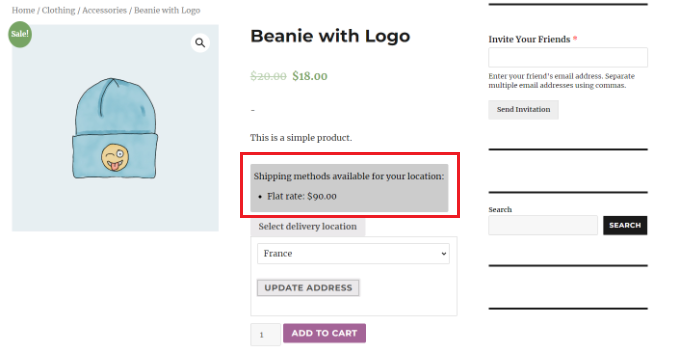
A shipping calculator is a tool that allows customers to estimate their total costs, including shipping and taxes, before they reach the checkout page.
By entering their location and viewing the products in their cart, shoppers can see an accurate breakdown of all costs involved in their purchase. This transparency can significantly reduce the likelihood of cart abandonment due to unexpected expenses.
7. 11% of users don’t complete their purchases because they don’t want to create an account.
For shoppers who may only visit your online store once, creating an account can feel like an unnecessary hurdle. This reluctance can significantly impact your shopping cart abandonment stats, especially if account creation is mandatory.
One effective cart abandonment solution to address this issue is to allow guest checkout. WooCommerce, a popular eCommerce platform, actually has this feature built in.
It allows customers to place orders without creating an account while still giving them the option to log in to an existing account during checkout.

Another strategy to address this issue is to offer social login options. You can allow customers to log in via Google or Facebook, making the account creation process much faster and easier.
8. 11% of users leave their carts because they don’t trust the site with their credit card information.
Credit card information theft is a highly concerning cybersecurity issue for online shoppers. So it’s a no-brainer that many people are hesitant to buy from a new eCommerce store.
One of the fundamental cart abandonment solutions to build trust is using an SSL certificate on your website.
SSL (Secure Sockets Layer) is a security protocol that creates an encrypted link between a web server and a browser. This encryption ensures that all data passed between the web server and browser remains private and secure.

You can also build trust by ensuring your payment processing is PCI-compliant.
PCI DSS (Payment Card Industry Data Security Standard) is a set of security standards designed to ensure that all companies that accept, process, store, or transmit credit card information maintain a secure environment.
If you’re unsure what payment tool to use, you can check out our list of the best credit card processing plugins for WordPress.
Displaying security badges is another effective strategy to reduce cart abandonment rates. You can obtain these trust certificates from various internet security and trust agencies like Norton, McAfee, Better Business Bureau, and more.
These badges serve as visual cues that reassure customers about your site’s security. Here’s how we implement this on our brand sites:

More Stats on Why People Abandon Online Shopping Carts
- 10% of consumers abandon their carts because the delivery options are too slow.
- 18% of users leave their carts because the checkout process is too long.
- 9% of people don’t complete their purchases because they cannot see the total cost of their order upfront.
- 8% of users abandon their carts because they aren’t happy with the store’s return policy.
- 7% of consumers leave their carts because the website is prone to errors and crashes.
- 17% of users cite lack of trust as a cause for abandonment, fearing credit card theft or other security concerns.
- 4% of consumers leave their carts because their credit card is declined.
Checkout Optimization Trends to Prevent Cart Abandonment
Let’s explore some effective strategies to optimize your checkout process and reduce cart abandonment.
9. Improving your checkout process can increase your conversion rate by 35%.
This makes sense because the easier it is for your customers to check out, the faster and more likely they are to complete their purchases.
One of our favorite tools for improving a checkout page is FunnelKit Builder. This WooCommerce sales funnel builder comes with ready-made checkout templates and forms optimized for conversions.
Plus, you can add an express checkout button to speed up the conversion and a sliding side cart to allow users to review their purchases before paying.
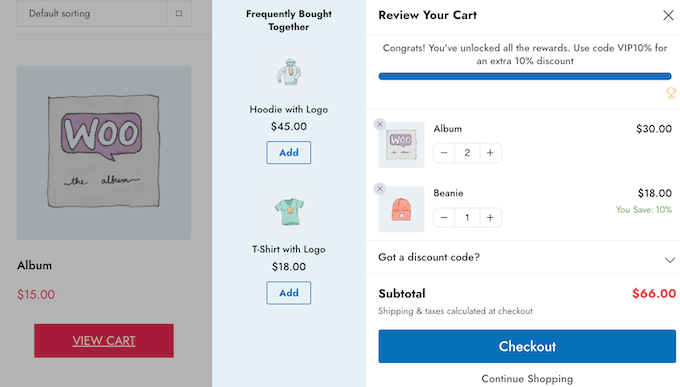
Another tool we love is SeedProd, which we also use for creating custom pages in WPBeginner and other brands. It’s a drag-and-drop page builder that makes it easy to design your website.
This page builder integrates with the WooCommerce plugin. When it detects that you have WooCommerce installed, you can create a custom page and add a user-friendly and optimized checkout block for users to place their orders.
You can also add a bestselling product block to show popular items to your customers. This can be a form of upselling to encourage users to purchase more items, increasing your average order value.
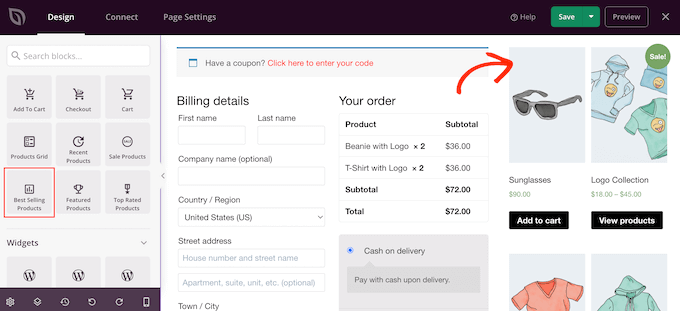
For more information, head over to our article on how to customize the WooCommerce checkout page without code.
10. The ideal number of checkout form fields is 8, but most sites have around 11.
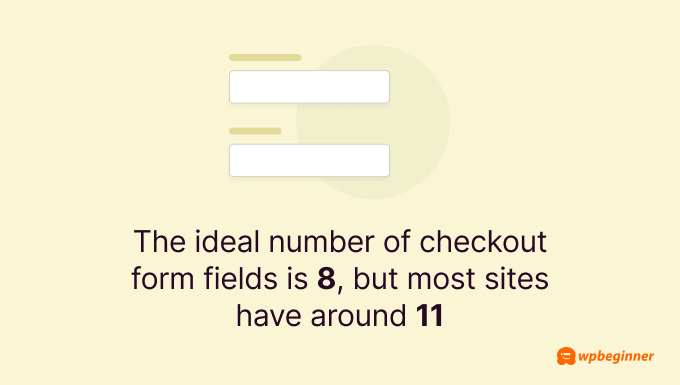
On average, a checkout form should have fields for the customer’s name, email address, shipping address, and payment information.
However, many online stores add other fields to request additional information that may not be essential for completing the purchase. Online stores often do this to gather more customer data for marketing purposes or to improve their logistics processes.
The rule of thumb for reducing the effects of shopping cart abandonment is to ask for only what’s necessary and, if possible, use features that make the form appear less daunting.
For example, you could use a dropdown for country selection instead of a text field or implement conditional logic that only shows certain fields based on previous responses.
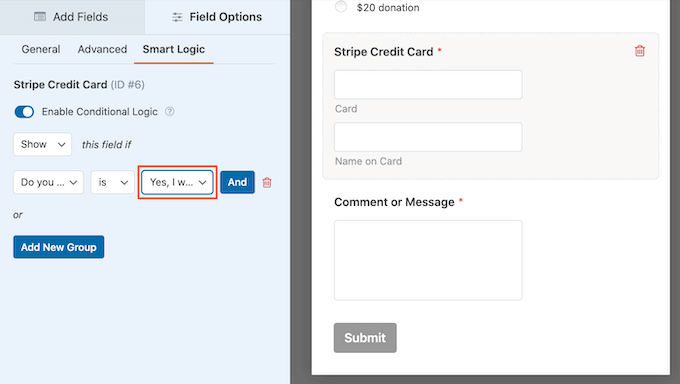
A form plugin like WPForms has features like this at the ready, and you can use it to process payments on your online store. You can check out these guides below to add a checkout form with WPForms:
- How to Create a One-Click Checkout in WordPress
- How to Create a WordPress Form with Payment Options (Easy Way)
11. When using a single ‘Name’ or ‘Full Name’ field, 96% of users fill it out without hesitation, but most websites split names into two separate boxes.
This one-field approach might seem like a small thing, but it can really help lower your abandoned cart rate.
Why does it work? It’s simple: it looks shorter and feels quicker to fill out. In online shopping, where every second matters, these little improvements can lead to fewer abandoned carts.

A study by the Baymard Institute found that people had no problems typing their names in one ‘Name’ field. However, with separate first and last name fields, people often get confused or make mistakes, especially on phones with small screens.
Another point to consider is the use of title fields (Mr., Mrs., Ms., etc.). Unless this information is essential for your business operations or customer service interactions, it’s often best to skip this dropdown altogether.
12. 24% of online stores ask for separate billing and shipping addresses, even though it makes the checkout look longer than it needs to be.
For many customers, the shipping and billing addresses are the same. Having to fill out the same information twice can be frustrating for shoppers and may cause them to leave your online store.
To aim for a good shopping cart abandonment rate, try adding a checkbox or button that allows users to indicate that their billing and shipping addresses are the same. This way, they only need to enter the information once, significantly speeding up the checkout process.
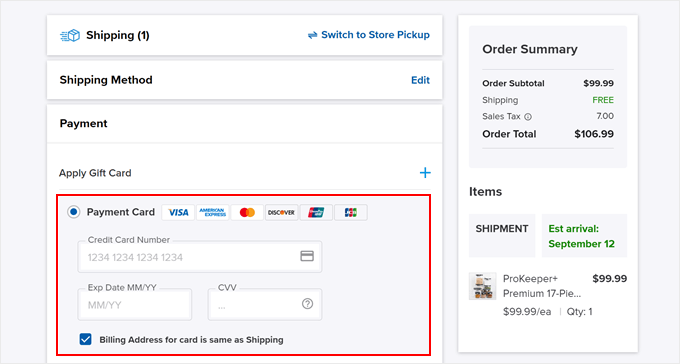
Another helpful feature is adding autocomplete for address fields. This tool suggests full addresses as the customer starts typing, pulling from a database of valid addresses.
Not only does this save time, but it also reduces errors in data entry.

More Best Practices for Optimizing Checkout
- Offering a simple and fast online buying experience leads to 55% of people completing their purchases.
- The average checkout flow is around 5 steps long and contains 13 form fields.
- 49% of payments for online purchases are made through digital wallets like PayPal.
- 70% of online stores have coupon code fields in their checkout forms, but don’t auto-apply a discount, which makes many users leave the site to find a coupon code.
- 75% of online stores have 2 address lines, even though removing one can simplify the form without inconveniencing most users.
- 84% of sites immediately ask users to create an account upon checkout, which often leads to higher abandoned cart rates.
- 72% of mobile sites don’t properly introduce, position, and style error messages in checkout.
- 67% of mobile sites don’t use the right keyboard layout for relevant fields, which can slow down the checkout process.
- 66% of sites retain data in sensitive credit card fields after the user experiences a payment error, which can help reduce cart abandonment.
eCommerce Marketing Strategies to Solve Cart Abandonment
Beyond checkout optimization, there are several marketing tactics you can use to tackle cart abandonment.
13. Exit-intent popups can recover 53% of abandoned carts.
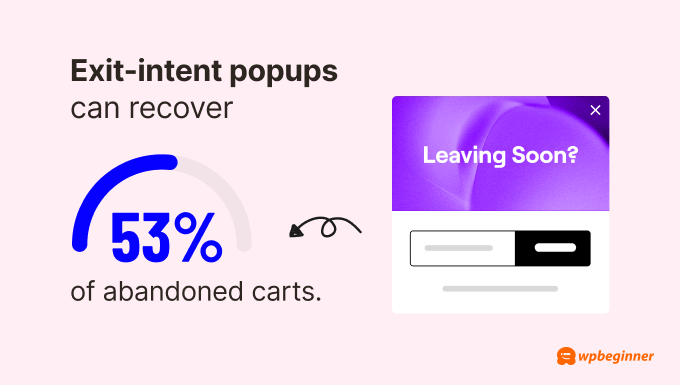
Exit-intent popups appear when a user is about to leave your website. They detect mouse movements that indicate the visitor is heading toward the browser’s close button or address bar.
By implementing exit-intent popups, you have one last chance to convince a potential customer to complete their purchase before they leave your site.
Thomas Griffin, OptinMonster co-founder, shared this in his guest post about the psychology of popups:
OptinMonster can use InactivitySensor to time when a user has been inactive, or Exit-Intent technology to sense the exact moment they are about to leave your website.
Using these strategies has allowed online businesses like Shockbyte to increase their signups by more than double, so it’s worth playing around with different timing rules to see what works for your business.
Thomas Griffin
However, simply reminding users about their cart isn’t always enough to achieve a good shopping cart abandonment rate.
To truly attract users and reduce cart abandonment, you may need to offer an additional incentive. This can be a discount code, free shipping, or a bundle deal.
14. 54% of consumers read at least 4 reviews before buying something online.
Reviews can help build trust and make customers feel more confident about their purchases.
To make the most of reviews, we recommend signing up for a Google Business Profile if you have a physical store or Trustpilot for online-only businesses. These platforms let you collect genuine customer reviews that you can then show on your website.
To display these reviews on your site, you can use the Smash Balloon Reviews Feed plugin. This tool lets you pull in reviews from other sites and show them on your own pages. This way, shoppers can see what others think about your products without leaving your site.
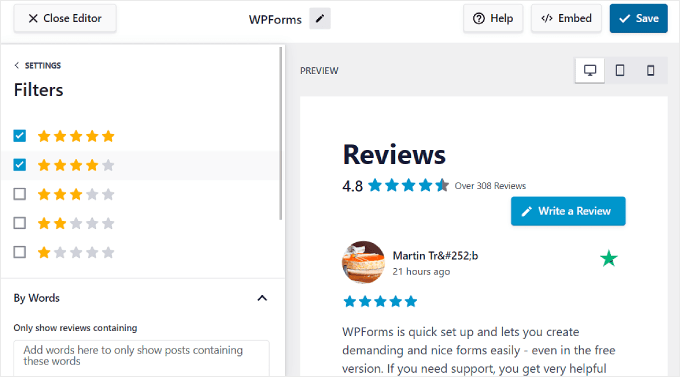
15. 40% of users who see personalized ads end up converting into customers.
Personalized ads are advertisements on search engines or social media platforms that are tailored to users based on their interests, browsing history, and previous interactions.
The goal is to present potential customers with products or services they’re more likely to be interested in, increasing the chances of them clicking through and making a purchase.
However, to truly prevent cart abandonment, the personalized experience shouldn’t stop at the ad itself. Once a user clicks on your personalized ad and arrives at your website, you should present them with a landing page that’s tailored to match that specific ad.
With the SeedProd page builder, you can easily create custom landing pages tailored to specific marketing channels or ad campaigns.
We’ve put together comprehensive guides on how to create a Facebook ad landing page and how to make a Google ad landing page.

More Marketing Trends to Solve Cart Abandonment
- 98% of consumers read reviews before making a purchase.
- 82% of people say that they’ve been convinced to buy a product or service by watching a brand’s video.
- 70% of people are more likely to buy from a brand if they have a good experience with them on social media.
- 54% of shoppers are more likely to come back and finish their order if they’re offered a discount.
- 45% of consumers stay loyal to a retailer because of regular discounts, loyalty points, and incentives.
- 41% want to see more personalized recommendations and deals.
- 46% of shoppers have left items in their cart because a discount code didn’t work.
- Retargeting ad campaigns that encourage people to complete their purchases can have a return on investment of 1300%.
Best Practices for Cart Abandonment Emails
One of the most effective ways to recover abandoned carts is through well-crafted emails. Here are some tips and tricks you can use to design your email sequence:
16. The average conversion rate for a cart abandonment email sequence is around 3%.
While that number might seem small, these timely reminders go out to customers who have already shown interest in your products.
Even at this rate, these automated emails can recover a significant amount of lost revenue for your store.
If you’re running a WooCommerce store, you can take advantage of this powerful tool. We have a detailed guide on how to set up WooCommerce abandoned cart emails that walks you through the process.
In the next sections, we’ll look at some trends in abandoned cart emails. These insights will help you craft more effective messages and boost your recovery rates.
17. Sending multiple abandoned cart emails can lead to 69% more orders than sending just a single one.

So, instead of sending just one reminder email after a customer abandons their cart, these businesses would send a series of 2-3 emails over a few days.
For example, your email sequence might look like this:
- First email (1 hour after abandonment): A friendly reminder about the items left in the cart.
- Second email (24 hours later): Offer a small discount or free shipping to encourage purchase.
- Third email (3 days later): Create urgency by mentioning limited stock or that the offer is ending soon.
This approach works because it gives you multiple chances to re-engage the customer. Some people might need a simple reminder, while others might be swayed by a discount or a sense of urgency.
That being said, make sure not to send all the emails in one day or repeat the same information in all your emails. Otherwise, you might sound pushy, which could turn potential customers away.
With FunnelKit, you can set up an email sequence where you can select the triggers and delays for each message. This way, you can automate your abandoned cart email strategy without overwhelming your customers.
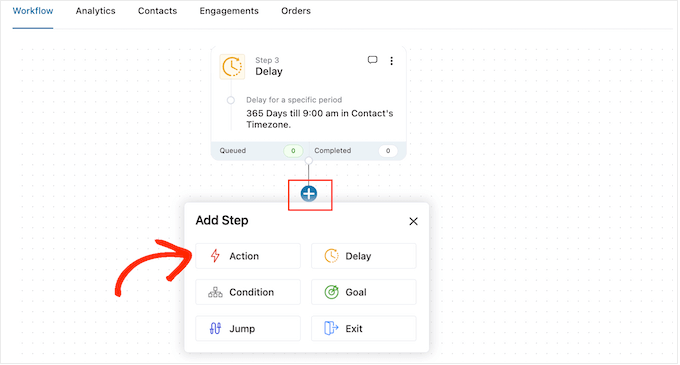
18. 44% of abandoned cart emails use scarcity to urge customers to complete their purchases.
If you don’t want to offer money-based incentives in your emails, scarcity is a great option for attracting users back to your online store.
Scarcity here means creating a sense of urgency by highlighting that items are low in stock or in high demand. The idea is to convey that if customers don’t act quickly, the products they’re interested in might not be available later.
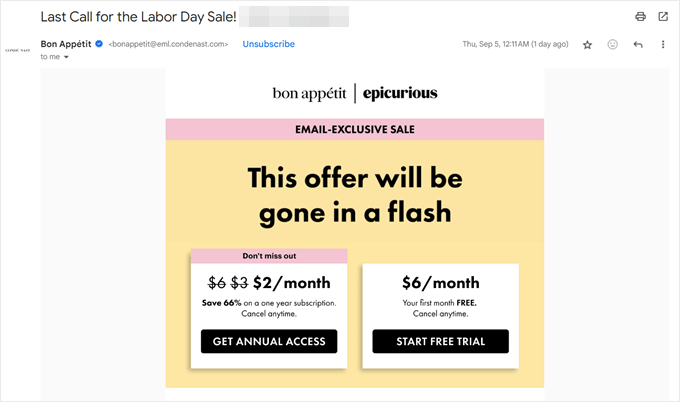
You can use scarcity by mentioning that only a few items are left in stock or emphasizing that the product is only available for a limited time. With the second option, you could add a countdown timer to your email to visualize the urgency.
19. The best time to send a cart abandonment email is between 30 minutes and 1 hour after the user leaves their purchase.
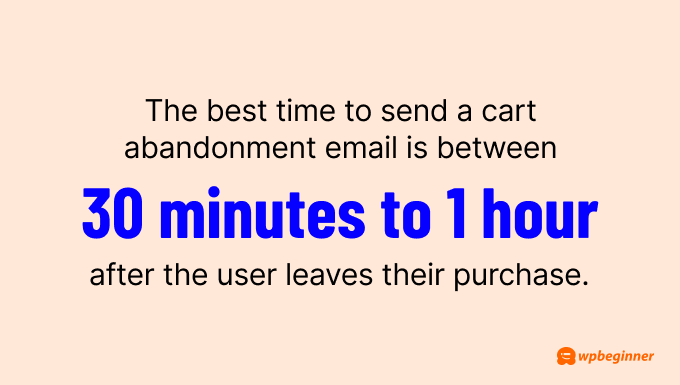
Why not sooner than 30 minutes? Sending an email too quickly might come across as pushy or desperate. You should give customers a brief moment to reconsider their decision on their own.
Plus, they might have just stepped away temporarily and could return to complete the purchase without prompting.
And why not later than 1 hour? Waiting too long risks losing the customer’s interest or having them forget about their potential purchase altogether. After an hour, they might have moved on to other tasks or even found a similar product elsewhere.
That being said, while this timeframe is generally effective, it’s always a good idea to test different timings with your specific audience to find what works best for your business.
If you use FunnelKit, you could add split testing to your sales funnels and email marketing campaigns. This can help you determine the most effective timing, content, and design for your abandoned cart emails.
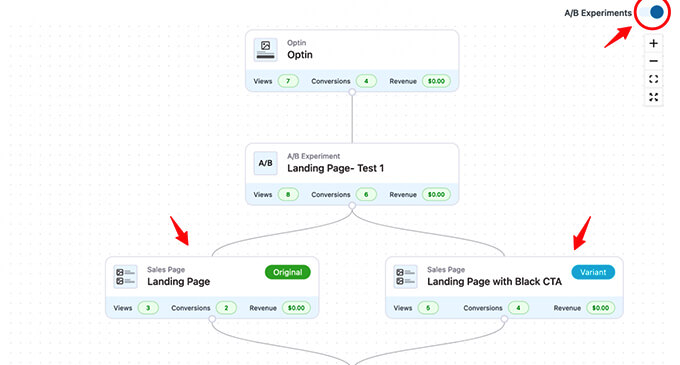
More Cart Abandonment Email Statistics
- The average open rate for cart abandonment emails is 50.5%.
- The average click rate for cart abandonment emails is 8.38%.
- The average conversion rate for cart abandonment recovery emails is 3%.
- Less than 50% of people who click on cart abandonment emails are likely to complete their purchases.
- 68% of abandoned carts triggered an abandoned cart email.
- 35% of brands include offers in their cart abandonment emails.
- 90% of the emails showed the user’s abandoned purchases with images.
- 81% of offers in cart abandonment emails are percentage discounts, 12% are dollar discounts, and 5% offer free shipping.
- 50% send their first offer in the first email, 30% in the second, and 18% in the third.
- 21% sent three cart abandonment emails, 16% sent two, 7% sent four, and 2% sent five or more.
- In subject lines, 44% mentioned the offer, 18% mentioned ‘cart’, 12% used ‘complete your purchase’, 10% used a question format, and 9% used the word ‘forget’.
- Among all email marketing campaigns, abandoned cart flows drive the highest average repeat purchase rate of $3.65 and the highest average placed order rate (3.33%).
Store Policies That Can Make or Break Your Conversions
Your store policies play a crucial role in a customer’s decision to complete a purchase. Take a look at how returns and shipping policies can cause or prevent cart abandonment.
20. An easy return policy can convince 35% of shoppers to complete their purchases.
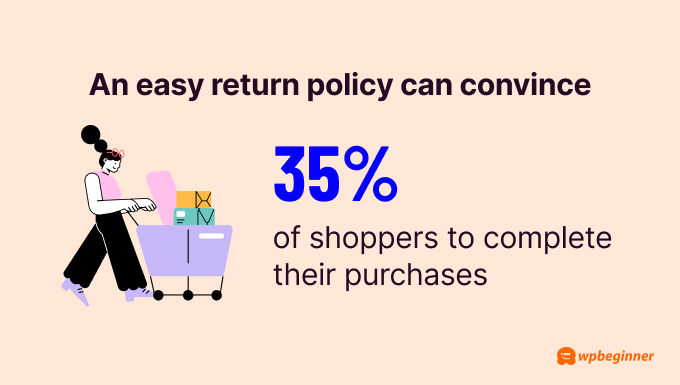
Many customers feel more comfortable making a purchase when they know they can return the item if it doesn’t meet their expectations.
Lululemon’s approach is a great example of an effective return policy that helps achieve a low shopping cart abandonment rate. Their policy is clear and customer-friendly, addressing many common concerns that often lead to cart abandonment.

They detail how long returns are acceptable, provide links to the closest store locations for in-person returns, and clearly outline the criteria for returns. Additionally, they include a comprehensive FAQ section to address common questions and concerns.
21. 73% of shoppers say they like to buy products online if they can get free shipping.
People like the idea of getting something for ‘free’ and don’t want to be surprised by extra costs at checkout, which often causes them to leave without buying.
Shipping discounts like free shipping can be a great way to reduce cart abandonment across many types of online stores. But it’s important to know that free shipping isn’t really free for the business.
Usually, the cost is just added to the product price, or you could offer free shipping only on orders over a certain amount to encourage people to buy more.
If you decide to offer free shipping, make sure to show it clearly all over your website with a free shipping banner. Put it on your homepage, product pages, and in the shopping cart. This reminds customers about the offer and can help stop them from abandoning their carts.

22. Two-thirds of US consumers think that fast, two-day delivery is important.
People might leave their carts if they think shipping will take too long.
To tackle this, it’s best to work with well-known shipping companies like USPS, FedEx, and UPS. These recognized names in the logistics industry can help you offer faster, more reliable shipping options.
Besides fast shipping, it’s also good to let users track their shipments. This way, customers feel more in control and can plan for when their package will arrive.
You may also want to set up delivery time slots on your online store. This allows customers to choose a specific time for their delivery, making it more convenient for them.

More Store Policy Trends That Can Affect Cart Abandonment
- 82% of shoppers say they like to purchase when they get free shipping.
- 80% of American shoppers expect free shipping above a certain order threshold.
- Free shipping has led to a 90% increase in eCommerce orders.
- 58% of shoppers pay more or add more products to their carts to get free shipping.
- Free returns policies can increase customer loyalty by 72%.
- Fast return service can boost customer loyalty by 66%.
- Extended returns deadlines can increase customer loyalty by 64%.
- A sustainable returns process can increase customer loyalty by 55%.
- 88% of shoppers stopped buying after a paid return policy was introduced.
- 57% of mobile sites don’t have direct links to ‘Return Policy’ and ‘Shipping Info’ in the footer, which can lead to higher mobile cart abandonment rates.
eCommerce Tech Trends to Reduce Shopping Cart Abandonment
Let’s delve into how technology can help you combat cart abandonment and boost sales.
23. Online stores that use automation for cart abandonment say their conversion rates increase by 50%.
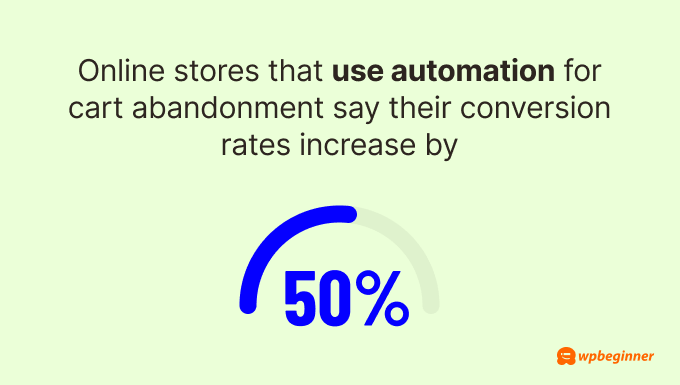
In this case, automation means using technology to automatically send reminders or incentives to customers who have left items in their cart, so you don’t have to do it manually.
One example of automation is running an automated marketing campaign using push notifications instead of emails. These notifications go directly to the user’s web browser or mobile device, resulting in a much higher engagement rate, similar to SMS messages.
The easiest way to set up automated push notifications is with PushEngage. It’s the best web push notification software for WordPress, and it’s what we use on our brand sites to send push notifications.

Another example of automation is using store activity notifications or FOMO (Fear of Missing Out) marketing. This strategy shows potential buyers that other people are purchasing the product they’re considering, acting as social proof.
Our tool for this is TrustPulse, and it has helped us a lot in reducing our average cart abandonment rate by creating a sense of urgency and popularity around our products.

If you want more ideas, we have a full list of WooCommerce automations that you can use to increase sales.
24. Predictive AI can reduce cart abandonment rates by 18%.
While predictive AI might sound like a fancy feature, it’s actually quite simple in practice. It can be as straightforward as personalizing your product and content recommendations so that users are more likely to complete their purchase.
Another way to use AI is by optimizing your copy on product descriptions, landing pages, popups, and more.
For example, the SeedProd page builder comes with an AI content generator to help you improve your website content and make users more likely to convert.

OptinMonster also has a Smart Optimization feature that uses artificial intelligence to help improve the content of your marketing campaigns.
Basically, it can look at the words you’ve written for your popup and suggest better ways to say it. These suggestions are made by AI and are meant to increase the likelihood of people buying from you.

For more information, you can check out our tips and tricks on how to use AI to skyrocket your marketing campaigns.
25. 1 in 3 shoppers want to use their phone to see how furniture looks in their home before buying, using Augmented Reality.
Furniture is often expensive and takes up significant space in a home.
Customers want to be sure their purchase is worth it and fits well in their space before committing.

A great example of a company using AR is IKEA.
They have an app that lets customers see how furniture would look in their homes before buying. This allows shoppers to feel more confident about their purchases, which can lead to a lower average abandoned cart rate.
26. Using AI chatbots to help shoppers can increase the number of orders by 26%.

An AI chatbot is a computer program that can talk to customers in a way that feels natural, almost like chatting with a real person. It uses artificial intelligence to understand what customers are asking and provide helpful answers.
One way chatbots can help is by answering frequently asked questions (FAQs) right on the page where customers are shopping. This means users don’t have to switch to a separate FAQ page, which might distract them from their purchase.
This is actually how we handle pre-sales questions in many of our projects. It’s like having a sales team that’s always awake, ready to answer questions right away, and keep potential buyers interested.

More Tech Trends to Reduce Abandoned Carts
- 84% of eCommerce businesses place AI as their top priority.
- 85% of online conversations with shoppers are handled by AI and chatbots.
- 51% of people are more likely to keep buying from an online store that offers live chat support.
- 95% of chatbots can provide solutions to customer issues in about 5 seconds.
- 42% of shoppers would like to be able to try on clothes virtually, which could help reduce returns and increase confidence in purchases.
- WooCommerce sees an average cart abandonment rate of 70% to 75%.
- WooCommerce offers at least 11 official extensions to recover abandoned carts, excluding the ones that are only sold in third-party marketplaces.
Frequently Asked Questions About Shopping Cart Abandonment
Here are some questions that our readers have frequently asked us about shopping cart abandonment:
What is considered a good shopping cart abandonment rate?
While the average cart abandonment rate is around 70%, a “good” rate can vary significantly by industry. Generally, a rate below 60% is considered strong.
However, the most important goal is to consistently improve your own rate, as even small reductions can lead to a significant increase in sales.
How do you calculate the cart abandonment rate?
You can calculate your cart abandonment rate with a simple formula. First, divide the number of completed transactions by the total number of shopping carts created. Then, subtract that number from 1 and multiply by 100 to get the percentage.
The formula is: $$ \text{Abandonment Rate} = \left( 1 – \frac{\text{Completed Transactions}}{\text{Carts Created}} \right) \times 100\% $$.
What is the number one reason for cart abandonment?
The leading cause of cart abandonment is unexpected extra costs. Shoppers are often surprised by high shipping fees, taxes, or other charges that only appear at the final stage of checkout, causing them to abandon their purchase.
Sources:
AppicSoftwares, Baymard Institute, BigCommerce, Dynamic Yield by Mastercard, Emarsys, FinancesOnline, Future of Commerce, Hostinger, Hotjar, Klaviyo, Mailmodo, Moosend, NotifyVisitors, OptinMonster, Rejoiner, SaleCycle, Statista, Yaguara
We hope this list of shopping cart abandonment rate statistics can help you improve your online store’s conversions.
You may also want to check out our other research guides below:
Discover More Stats and Trends to Optimize Your Online Store
- Impressive eCommerce Statistics You Won’t Believe
- Surprising Customer Service Statistics and Trends
- Marketing Statistics, Trends, and Facts (Updated)
- Important Online Payment Statistics, Data, and Trends
- Affiliate Marketing Statistics You Need to Know
- Content Marketing Trends — What’s Hot and What’s Not
- Social Media Statistics (Ultimate List for Bloggers)
- Influencer Marketing Statistics You Should Know
- Mindblowing SEO Statistics and Trends (Ultimate List)
- Surprising AI Statistics – Everything You Need to Know
If you liked this article, then please subscribe to our YouTube Channel for WordPress video tutorials. You can also find us on Twitter and Facebook.

 Thomas Griffin
Thomas Griffin



Dennis Muthomi
The checkout optimization section was super helpful, especially the point about reducing form fields to 8 instead of 11. As an online store owner I implemented a one page checkout and saw a huge drop in abandonment rates. I also offer guest checkout and that aligns with the stat about 11% of users abandoning carts because of account creation requirements. Small changes can make a big impact.
Jiří Vaněk
Thanks for collecting these statistics. I would be interesting to compare them before Covid pandemy. In our country during the Covid pandemy many people change theirs behavior about buying products. Many people switched theirs shopping habits to online world.